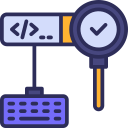Automating Audit Processes through Programming
Automating audit processes through programming is reshaping the way organizations handle compliance, risk, and financial analysis tasks. By integrating software solutions and custom scripts into their workflows, companies can achieve heightened efficiency, improved accuracy, and robust data analytics capabilities in their audit procedures. Leveraging programming not only reduces manual effort but also provides a scalable framework for continuous monitoring and transparency. This page explores the profound impact of programming on audit automation, delving into its benefits, core technologies, best practices, and the future it heralds for audit professionals.


Numerous audit routines involve repetitive tasks such as data extraction, reconciliation, and validation of records. Programming automates these processes by allowing scripts to handle large data sets with logic and accuracy unattainable manually. Automated checks can swiftly pinpoint anomalies, highlight missing documentation, or flag out-of-policy transactions. This means auditors can devote more attention to higher-level analysis instead of spending countless hours on data gathering or simple arithmetic. Reliable automation not only speeds up audits but also ensures consistency and completeness, minimizing compliance risks brought by human oversight.

Traditional manual audits may require weeks or even months to gather data, test controls, and generate findings. Programming introduces automation that compresses these timelines by running audit processes on a scheduled or continuous basis. Data inputs from multiple sources can be captured, cleansed, and analyzed in real time. Bots and scheduled scripts ensure recurring tasks are completed in the background, allowing auditors to access up-to-date findings without delay. This acceleration not only meets business needs for quicker turnaround but also facilitates more responsive compliance reporting.

Even the most diligent auditors can misunderstand complex rules or overlook subtle transaction patterns when working manually. Programming introduces rigor and repeatability, minimizing the probability of human error. Scripts execute instructions exactly as coded, ensuring every data point is treated with uniform criteria. Automated exceptions handling further streamlines the process by flagging outliers and unexplained variances for review, supporting a higher standard of precision. This reliability builds trust in audit outcomes and supports clearer documentation for regulatory and management oversight.
Scripting Languages
Popular scripting languages such as Python and R have become indispensable in audit automation due to their versatility and extensive libraries. These languages enable auditors to automate tasks ranging from data fetching to advanced analytics with concise and readable code. With built-in or third-party packages for data manipulation, visualization, and machine learning, scripting languages reduce barriers for auditors to create, test, and deploy automation routines. Their open-source nature encourages collaboration and rapid innovation, which is essential for keeping up with the evolving field of audit technology.
Audit Management Software
Specialized audit management platforms, both proprietary and open-source, play a pivotal role in organizing and automating audit workflows. These platforms often come bundled with user-friendly interfaces and programmable modules, making it easier to assign tasks, document findings, and track progress in real time. Integration capabilities allow these solutions to pull data from ERP systems, cloud services, and database repositories—automating data collection and ensuring centralized, audit-ready documentation. Such software also supports compliance with regulatory standards, reducing the administrative burden on audit teams.
Artificial Intelligence and Machine Learning
Artificial Intelligence (AI) and Machine Learning (ML) are rapidly advancing the efficiency and scope of audit automation. Through pattern recognition and predictive analytics, AI algorithms can detect fraud, forecast risks, and highlight compliance gaps that may elude standard rule-based scripts. ML models improve with exposure to new data, enabling more sophisticated analyses of unstructured and high-volume transactions. As these tools evolve, they support auditors in transitioning from retrospective checks to proactive governance and risk management, laying the foundation for truly continuous audit processes.
Best Practices for Implementing Audit Automation
Effective audit automation starts with a thorough understanding of current processes and pain points. Detailed process mapping helps identify which tasks are suitable for automation and where programming will yield the most significant efficiency gains. By closely collaborating with audit professionals, IT teams can design workflows that replicate manual checks while introducing opportunities for improvement. Clear documentation during this phase ensures that automated solutions are aligned with strategic goals and are readily auditable by internal or external reviewers.
